The miracle in the Almighty’s saying: He said: Your appointment is the Day of Adornment.
Praise be to God and prayers and peace be upon the Messenger of God and upon his family and companions, all of them.
The Lord of Glory says in His perfect revelation: He said, “Your appointment is on the day of adornment, and that the people be gathered at noon.” (59) But Pharaoh turned away and gathered his plan, then he came. (60) Tafsir al-Tabari: ((( God Almighty says : Moses said to Pharaoh when he asked him to set a time for the meeting between them: ( Your appointment ) for the meeting ( is on the day of adornment ) meaning a day of celebration that they had.))) These are Pharaonic drawings that show that the day of adornment fete d’opet was actually a day of celebration that the ancient Pharaohs celebrated:


http://www.lesphotosderobert.com/Egy...uxor/opet.html
French/Arabic translation link: Click here
Translation : The Feast of Decorations , called in Pharaonic times " Heb-Nefer-Unepet ", was celebrated every year in the second month of the flood season (the Pharaonic month of Phaophi). The duration of the celebration varied from one ruling Pharaonic family to another. For example, under the rule of Queen Hatshepsut , the duration of the Feast of Decorations was 11 days , and during the reign of Ramses III, the duration was 27 days .
Objection
4 - That this is one of the expressions that go beyond the linguistic definition, which is one of the things that sometimes occurs in the speech of the Arabs or in the Quran,
such as the metaphor that expresses the whole by a part of it or by some of its contents, or vice versa,
and expressing a thing by its opposite,
and using a word that has two opposite meanings: such as the word “mawlah” = the man’s master or his slave or one of his allies whom he protects!!!
But this possibility also lacks research (to apply it to this verse).
It differs from one ruling pharaonic family to another. For example, under the rule of Queen Hatshepsut , the duration of the Festival of Decoration was 11 days , and during the reign of Ramses III, the duration was 27 days . |
Peace be upon you and God's mercy and blessings.
If this is true, then there is no escape from one of the possibilities (because God Almighty says on the tongue of Pharaoh: "The Day of Adornment" which suggests that the holiday was one day, otherwise why did He not mention a specific day of this holiday?!):
1 - That the holiday intended in the verse (the Adornment) is not this holiday mentioned here.
2 - That this Pharaoh is not Ramses, but rather another Pharaoh who celebrates this holiday on one day only.
3 - If Ramses celebrates this holiday on one day only despite its continuation for 27 days , then this is acceptable, but it is something that lacks evidence.
The precision of the Qur’anic expression - if God wanted to express this holiday mentioned here (if it is the same as the Adornment Festival) - requires that He say: "Your appointment is on one of the days of Adornment", because it is 27 days or because it is more than one day. What
Responseeeee:
quote:
| That the holiday referred to in the verse (adornment) is not the holiday mentioned here. |
called fete du harem ( harem ) feast!!! Here are some sources (3), for example, but not limited to: The first source: http://membres.multimania.fr/egyptedan/dico-o.html The second source:

| This image is in another size. Click here to view the image in its correct form. The image dimensions are 696x152. |

http://khemet.online.fr/monuments/temples/louxor.html
Third source:
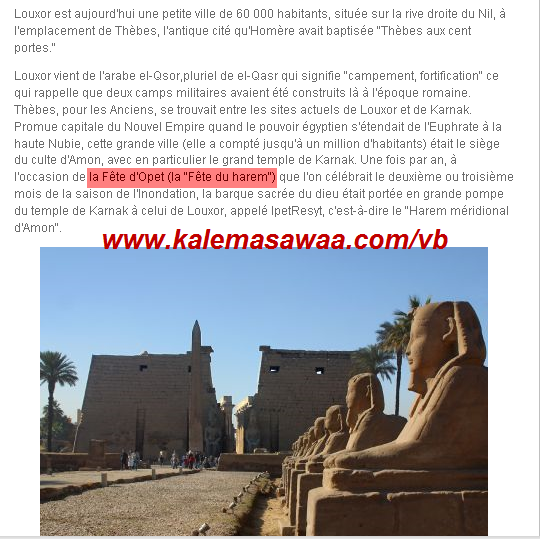
http://pharaons.free.fr/index.php?tag/Temple
Here is the definition of the French word harem, which means a place designated for women.
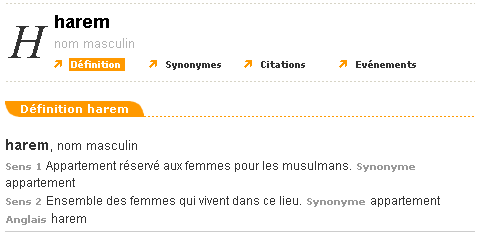
| Sometimes the word harem is synonymous with the word women , |
Don't you see, my dear brother, that there is a relationship - which is truly surprising - between the name of the holiday mentioned in the Qur'an ( the Day of Adornment ) and this holiday, opet, which is also called the Women's Day ????
quote:
| - That this pharaoh is not Ramses, but another pharaoh who celebrates this holiday on only one day. |
Please click here , here , here , and here. Here you go: Index: The Pharaohs testify to the truth of the message of Islam.
quote:
| 3- If Ramses celebrated this feast on only one day, despite it lasting 27 days , then this is acceptable, but it lacks evidence. |
but the Ramsesids (including Ramses II) extended the celebration to nearly a month,
which is what the document below indicates:

Perhaps the following scene explains the matter more:
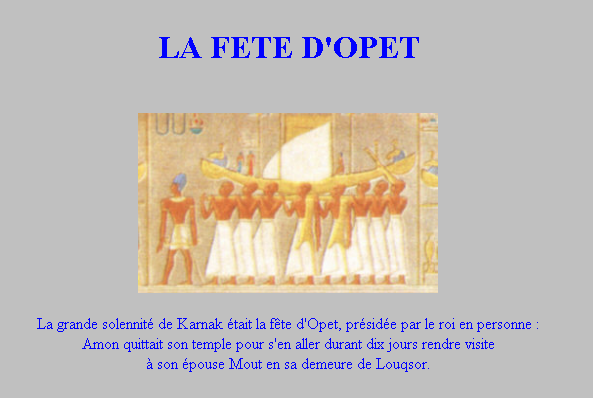
The king (Pharaoh) gives the start of the celebration of the Opet festival,
the god Amun leaves his temple (in Karnak) to visit his wife in Luxor,
the journey (in a decorated boat) will last 10 days,
http://yp.voyages.free.fr/Egypte/Pha...uvelle+Fenetre
*****
There is no doubt that the celebrations were - generally - between 11 and 27 days!
But....
the special and most important day is the day of the start of Amun's journey,
it is the day on which sacrifices (bulls) are presented!!
| This image is in another size. Click here to view the image in its correct form. The image dimensions are 659x157. |

Translation: The celebrations can last for 27 days, dedicated to a set of rituals, the most important of which is presided over by the king (referring here to the pharaoh presiding over the launch of Amun's journey). Sacrifices are presented to the gods in the form of bulls whose horns are decorated with flowers .
http://www.egyptos.net/egyptos/dico/mot-Fete-Opet.php
***********
Therefore, we cannot rule out the possibility that the Pharaoh celebrated this holiday on one day (which gave the start of the celebration) and the rest of the people celebrated throughout the 27 days! |
quote:
| 4 - That this is one of the expressions that go beyond the linguistic definition, which is one of the things that sometimes occurs in the speech of the Arabs or in the Qur’an, such as the metaphor that expresses the whole with a part of it or with some of its contents, or vice versa. |
and I apologize, my dear brother, for using the French language in documenting the topic, as it gives me a wider scope for research and documentation,
quote:
| What is the evidence that the big here = the biggest? |
quote:
| He is often regarded as the greatest , most celebrated, and most powerful pharaoh of the Egyptian Empire. |
Ramses II is considered the greatest , most famous, and most powerful of the pharaohs of the Egyptian Empire.
http://en.wikipedia.org/wiki/Ramesses_II
I believe, my dear brother, that the word “the greatest” is stronger and more significant than the word “the great.”
Ramses II was not only a god, but he considered himself above all the gods of the pharaohs.
http://en.wikipedia.org/wiki/Ramesses_II
I believe, my dear brother, that the word “the greatest” is stronger and more significant than the word “the great.”
Ramses II was not only a god, but he considered himself above all the gods of the pharaohs.
quote:
| The largest Pharoon of these temperatures, 2 GENIAL RAMSES, also includes the maintenance of this superior one. |
Translation: The greatest pharaoh in history is Ramses II, who was considered the embodiment of the supreme divinity,
émanation = embodiment or expression of the supreme divinity : the supreme divinity http://veritablenouvelordre.forum-ph...ion-egyptienne Another proof that Ramses II considered himself the supreme god,
the book:
Egyptological Bibliographyémanation = embodiment or expression of the supreme divinity : the supreme divinity http://veritablenouvelordre.forum-ph...ion-egyptienne Another proof that Ramses II considered himself the supreme god,
the book:
International Association of Egyptologists,W. Hovestreydt, LMJ Zonhoven
Page: 152
Page: 152
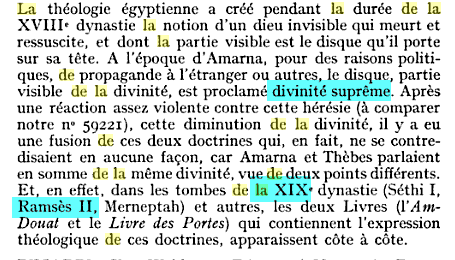
Translation: The concept of the death and resurrection of the hidden god appeared in pharaonic theology during the reign of the 18th dynasty. The only visible part of the latter is a disk that he carries above his head and indicates the supreme divinity .
In the tombs of the 19th dynasty (Seti I - Ramses II , Merneptah) theological phrases were found indicating this belief.
To browse the book, please click here.
quote:
| But did Ramses II claim that he was the only god, as is understood from Pharaoh’s statement in the Holy Verse? |
Ramses II considered himself the lord of all gods,
the only supreme deity .
Ramses II considered himself the living god, dieu vivant = the living god se prosternent = they prostrate themselves .
the only supreme deity .
Ramses II considered himself the living god, dieu vivant = the living god se prosternent = they prostrate themselves .
quote:
| Ramsès II is based on a living situation : all Egyptians who have developed this problem. There are no limits. |
Translation: Ramses II was like a living god, all Egyptians bowed down to him , his power had no limits,
http://conseils-astuces.over-blog.co...-71874808.html http://www.linternaute.com/dictionna...se-prosterner/
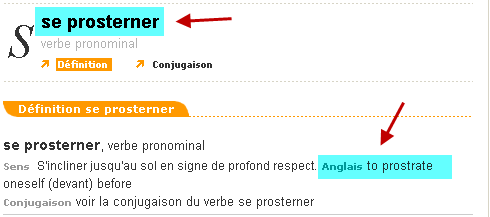
http://conseils-astuces.over-blog.co...-71874808.html http://www.linternaute.com/dictionna...se-prosterner/

quote:
| There is an important question: Was there no other king during whose reign this holiday was celebrated for only one day? |
It is very possible that there was another king during whose reign this holiday was celebrated only one day,
quote:
How do you explain, my dear brother, the presence of sea sand stuck to the body of Pharaoh Ramses II???
Comment on the Wikipedia article:
quote:
| King Ramses II was buried in the Valley of the Kings, in tomb KV7, but his mummy was transferred to the mummy cache at Deir el-Bahari, where it was discovered in 1881 by Gaston Maspero and transferred to the Egyptian Museum in Cairo five years later. Ramses was 170 cm tall, and medical examinations of his mummy show traces of red or dyed hair . It is believed that he suffered from severe rheumatism in the joints in his later years, as well as gum disease. |
Al-Tabari’s interpretation of the noble verse:
{92} So today We will save you with your body that you may be a sign to those who come after you. And indeed, many among the people, of Our signs, are heedless
of the statement in the interpretation of the Almighty’s statement: {So today We will save you with your body that you may be a sign to those who come after you.} The Almighty says to Pharaoh: So today We will carry you on the earth with your body, looking To you perishes whoever denies your destruction. {So that it may be a sign to those who come after you} meaning: For those who come after you among the people, a lesson to learn from you, so that they may be deterred from disobeying God, disbelieving in Him, and striving to spread corruption on His earth. An-Najwa: is a place that is elevated above the ground around it. From this is the saying of Aws bin Hujr: “So whoever is on his camel’s hump is like someone on his Najwat, and the one who is in a state of fear is like someone who walks with ulcers.” And the people of interpretation said something similar to what we said about that. Mention of those who said that: 13823 - Muhammad ibn Abd al-A'la narrated to us, he said: Al-Mu'tamir ibn Sulayman narrated to us, on the authority of his father, on the authority of Abu al-Salil, on the authority of Qays ibn 'Abbad and others, he said: The Children of Israel said to Moses: Pharaoh has not died. He said: So God brought him out to them, and they looked at him like a red bull . 13824 - Ya`qub ibn Ibrahim narrated to us, he said: Ibn `Ulayyah narrated to us, on the authority of Sa`id al-Jariri, on the authority of Abu al-Salil, on the authority of Qays ibn `Abbad, he said: He was one of the most knowledgeable people, or the most informed people, about the Children of Israel. He said: So he told us that when the first army of Pharaoh reached the sea, the horses were afraid of the flames. He said: And a representation of a horse from among them was a thin horse, and he smelled its scent - I think that is me - he said: So he slipped away and it followed him. He said: So when the last army of Pharaoh was finished in the sea and the last of the Children of Israel came out, the sea was ordered to close in on them, so the Children of Israel said: Israel: Pharaoh did not die, and he would never die! So God heard their denial of his prophet. He said: So he threw him on the shore as if he were a red bull that the children of Israel could see.
And this is a picture of Ramses II with his red hair:
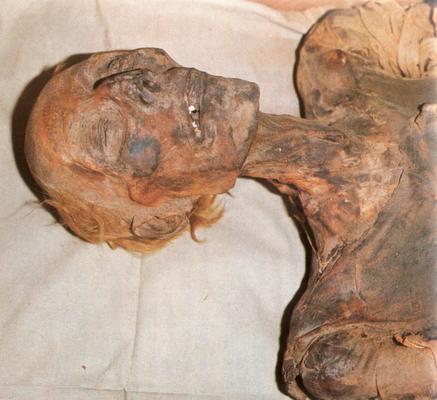
quote:
| Due to the reliance of Western scholars on what they have from the books of the Old Testament and with the tracking of the times mentioned in it, many orientalists and Western scholars thought that Ramses II is the same Pharaoh of Moses who was a contemporary of the presence of the Children of Israel in Egypt. Among the proponents of this theory are: Albright - Isvelt - Roxy - Unger - Father RP de Vaux. Those who see this have several opinions that try to prove this hypothesis. Some have gone so far as to say that if Ramses II ascended the throne in 1279 BC, then that was on May 31, 1279 BC. Based on the Egyptian date of his ascension to the throne, the third month of the Shemu season, on the 27th, but the theory of relying on dates is refuted, and perhaps the first to advocate this theory was Eusebius of Caesarea, who lived from 275 to 339 AD. |
The proof of this statement has been uploaded on my discord
Ramses II did not drown??
The results of the medical examination conducted on the mummy of Ramses II in France between 1976 and 1977 (the mummy remained in France for about 8 months) showed the presence of sand of desert origin and other sand of marine origin stuck to the body of Pharaoh Ramses II.
sable = marine sand
= marine
| This image is in another size. Click here to view the image in its correct form. The image dimensions are 915x70. |
http://www.biusante.parisdescartes.f.../article02.htm
What is the secret of the presence of sea sand stuck to the body of Ramses II, I wonder???
It is very likely that the Sham El Nessim holiday is the same as the decoration day,
but many evidences make us favor the “Obit” holiday or the “ Women’s Day ”.
Source 1: http://membres.multimania.fr/egyptedan/dico-o.html Source 2: http://khemet.online.fr/monuments/temples/louxor.html Source 3: http://pharaons.free.fr/index.php?tag/Temple

| This image is in another size. Click here to view the image in its correct form. The image dimensions are 696x152. |


Part of a research by Engineer Mohamed Abdel Razzaq Juwaili, which tells the story of the similarity of the descriptions of Moses’ Pharaoh with Ramses II!
Descriptions of Pharaoh Moses
It was mentioned in the interpretations that some of the Children of Israel lied about the death of Pharaoh and said that he does not die.. So he was thrown on the seashore until the Children of Israel saw him, red and short like a bull.. There are many other narrations that described Pharaoh when they saw him after he drowned, that he was bald and Akhens.. Akhens is the diminutive of Akhnas.. Al-Khans (with a high nose that is slightly set back from the face - Al-Khans = the nose is set back from the face with a slight rise in the bridge of the nose "Al-Qamoos Al-Muheet") .. There is a narration by Abu Bakr that he said: I was told that Pharaoh was afflicted with a broken tooth.. (Affliction: the breaking of a tooth from its root, or a tooth from the incisors or canines, or specific to the incisor. Afflicted, like rejoicing, so he is Athram.. Al-Qamoos Al-Muheet) and also (Affliction: the falling of the incisor and canine teeth, and it was said that it is the tooth being pulled out from its root absolutely.. Al-Nihaya fi Gharib Al-Athar). Thus, we can gather the characteristics of the Pharaoh of Moses as described by the companions of the Messenger of God, may God bless him and grant him peace: he was short, bald, and had a long nose.
Descriptions of Ramses II
By comparing these characteristics with the mummy of Ramses II in the Egyptian Museum, we find that his head is bald with some hair on the sides and back of his head, and that his nose is slightly prominent and slightly raised above the mouth, with his nose protruding at the top of his nose. There were also medical examinations conducted on the mummy of Ramses II in France in the late seventies during a treatment trip for his mummy, in which Dr. Smith mentioned that there were fractures in his teeth and abscesses, especially in the teeth of the front of the mouth. X-ray examination of the jaw and teeth of the mummy of Ramses II also showed the dental condition of the pharaoh at the time of his death, and it was found that there were foci of bone infection in an old man of about 90 years of age who had a normal, general, advanced loss of the molar area. The examination did not show any dental treatment that could be clarified by X-rays.
Thus, we find that all the characteristics mentioned in the stories about the drowned Pharaoh Moses almost match the mummy of Ramses II, except for one characteristic, which is his height. The stories mentioned that he was short, while the height of the mummy of Ramses II was 173 cm, meaning that he was of average height. And if I see that the description of height is relative... then perhaps this was short if they attributed it to the majority of the men of his time or to the Children of Israel who described him when they saw his body, for Moses and Aaron were tall, for the Messenger of God, may God bless him and his family and grant them peace, said: I saw Abraham, Moses, and Jesus, may God’s prayers be upon them. As for Moses, he was a tall man, tall, and of straight line, resembling the men of the Zutt and the men of the people of Shabwa... And al-Tha’labi said: Ka’b al-Ahbar said: Aaron bin Imran, the Prophet of God, was a man of eloquent tongue and clear speech, and when he spoke, he spoke slowly and knowledgeably. He was taller than Moses, and on his forehead was a mole, and on the tip of his tongue was also a mole. Moses bin Imran, the Prophet of God, was a tall, curly-haired man, as if he were from the men of Azd Shanu’a, and there was a heavy knot in his tongue, and he was quick and hasty, and there was also a black mole on the tip of his tongue.

It was mentioned in the interpretations that some of the Children of Israel lied about the death of Pharaoh and said that he does not die.. So he was thrown on the seashore until the Children of Israel saw him, red and short like a bull.. There are many other narrations that described Pharaoh when they saw him after he drowned, that he was bald and Akhens.. Akhens is the diminutive of Akhnas.. Al-Khans (with a high nose that is slightly set back from the face - Al-Khans = the nose is set back from the face with a slight rise in the bridge of the nose "Al-Qamoos Al-Muheet") .. There is a narration by Abu Bakr that he said: I was told that Pharaoh was afflicted with a broken tooth.. (Affliction: the breaking of a tooth from its root, or a tooth from the incisors or canines, or specific to the incisor. Afflicted, like rejoicing, so he is Athram.. Al-Qamoos Al-Muheet) and also (Affliction: the falling of the incisor and canine teeth, and it was said that it is the tooth being pulled out from its root absolutely.. Al-Nihaya fi Gharib Al-Athar). Thus, we can gather the characteristics of the Pharaoh of Moses as described by the companions of the Messenger of God, may God bless him and grant him peace: he was short, bald, and had a long nose.
Descriptions of Ramses II
By comparing these characteristics with the mummy of Ramses II in the Egyptian Museum, we find that his head is bald with some hair on the sides and back of his head, and that his nose is slightly prominent and slightly raised above the mouth, with his nose protruding at the top of his nose. There were also medical examinations conducted on the mummy of Ramses II in France in the late seventies during a treatment trip for his mummy, in which Dr. Smith mentioned that there were fractures in his teeth and abscesses, especially in the teeth of the front of the mouth. X-ray examination of the jaw and teeth of the mummy of Ramses II also showed the dental condition of the pharaoh at the time of his death, and it was found that there were foci of bone infection in an old man of about 90 years of age who had a normal, general, advanced loss of the molar area. The examination did not show any dental treatment that could be clarified by X-rays.
Thus, we find that all the characteristics mentioned in the stories about the drowned Pharaoh Moses almost match the mummy of Ramses II, except for one characteristic, which is his height. The stories mentioned that he was short, while the height of the mummy of Ramses II was 173 cm, meaning that he was of average height. And if I see that the description of height is relative... then perhaps this was short if they attributed it to the majority of the men of his time or to the Children of Israel who described him when they saw his body, for Moses and Aaron were tall, for the Messenger of God, may God bless him and his family and grant them peace, said: I saw Abraham, Moses, and Jesus, may God’s prayers be upon them. As for Moses, he was a tall man, tall, and of straight line, resembling the men of the Zutt and the men of the people of Shabwa... And al-Tha’labi said: Ka’b al-Ahbar said: Aaron bin Imran, the Prophet of God, was a man of eloquent tongue and clear speech, and when he spoke, he spoke slowly and knowledgeably. He was taller than Moses, and on his forehead was a mole, and on the tip of his tongue was also a mole. Moses bin Imran, the Prophet of God, was a tall, curly-haired man, as if he were from the men of Azd Shanu’a, and there was a heavy knot in his tongue, and he was quick and hasty, and there was also a black mole on the tip of his tongue.
Question
| I searched the internet for the word opet and found that it is the name of one of the Egyptian goddesses, Ippopotham. |
1- It is the name of one of the Egyptian gods Hippopotame,
2- The name of one of the gods of the New Kingdom that symbolizes the Luxor Temple,
3- The name of a temple in Karnak,
4- The name of a temple in Luxor (Harem al-Janub =ipet resyt),
5- The name of a Pharaonic festival/party/holiday, http://dictionnaire.sensagent.com/opet/fr-fr/ The Holy Verse spoke about a Pharaonic festival, and indeed there is a Pharaonic festival/holiday called opet . http://pantheonegyptien.free.fr/la_fete_d_opet_598.htm http://en.wikipedia.org/wiki/Opet_Festival http://www.odysseyadventures.ca/arti...ticle_opet.htm http://www.touregypt.net/featurestor...tfestival1.htm http://www.britannica.com/EBchecked/topic/429983/Opet
| This image is in another size. Click here to view the image in its correct form. The image dimensions are 990x360. |

quote:
| But what is the literal meaning of the word heb nefer en ipet? |
( please review the previous posts )
.....
heb = festival / festival / celebration

nefer = beautiful

ipet / opet = name of a temple in Luxor, also called ipet resyt ====> Harem of the South
Thus the meaning is: Ipet Festival, or the Beautiful Harem Festival . opet = name of a temple http://www.egyptologie.com/karnak.htm To be continued, God willing...
| This image is in another size. Click here to view the image in its correct form. The image dimensions are 766x125. |

ipet resyt Name of Luxor Temple: http://www.egypt-cairo.com/luxor/ipet_resyt.html Harem of the South =ipet resyt http://egyptopedia.fr/entree.php?lettre=A&entree=Amon * Note: When talking about the harem, we must talk about the decorations
| This image is in another size. Click here to view the image in its correct form. The image dimensions are 767x415. |


| This image is in another size. Click here to view the image in its correct form. The image dimensions are 948x105. |

We did not insert the word “Day of Adornment” in any way.
The “non-Islamic” sources above are the ones that mentioned that the “Opet” festival was called “Harim’s Festival.
” Everyone knows the passion and fondness of women (harem) for jewelry, ornaments, bracelets, and other forms of adornment..!
Regarding the word “adornment,” I remind you, my dear brother, of the previous document that says:
quote:
| The celebrations could last for 27 days, devoted to a group of rituals, the most important of which was presided over by the king (a reference here to the pharaoh presiding over the launch of Amun’s journey). Offerings were made to the gods in the form of bulls whose horns were decorated with flowers. |

Since you - as I see - are familiar with the French language, you will not find any difficulty in confirming that the word
ornait means ===========> decorate .
The verb orner means: to beautify , to decorate . http://www.linternaute.com/dictionna...inition/orner/ "Opet" was indeed a day of celebration and decoration . Frankly, I do not know what the objection is here, my dear brother???
| This image is in another size. Click here to view the image in its correct form. The image dimensions are 681x180. |


Comments
Post a Comment